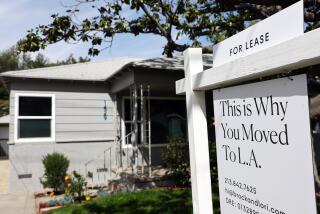Developers Target the Well-off Elderly
- Share via
In the 14 years during which America will approach the 21st Century, the pattern of residential living is likely to display increasing innovation for our burgeoning “woopie” population.
The evidence is preponderant in almost all areas of the nation. Builders and developers are turning more attention to the “well-off older people” whose numbers are expected to increase from an 11% of the total population to 18% within the next half-century.
James W. Wentling, an executive with a Philadelphia architectural and land planning firm, made two significant observations during a recent retirement housing conference (sponsored by Laventhol & Horwath):
--The over-85-year-old segment of the U.S. population is expected to increase by more than 150% in the next half-century.
--Increased demand for specialized housing will be created as the 1940s-born “baby-boomers” mature and become woopies at the turn of this century.
In the last 25 years, specialized housing for adult-only and retirement and life-care housing emerged as viable residential markets.
Wentling contends that the traditional housing options for the older Americans are for the active elderly in the 55-to-65 age group with a country club or resort atmosphere, and for the over-65 group that wants life-care health and meal services and private residences or rooms in small or large buildings.
However, a longtime Washington area resident, Edward Fitzgerald takes some exceptions to Wentling’s categorizations. A just-turned-60, retired resident of an all-adult community with a wide range of recreation activities--but no life/health care, Fitzgerald said that health considerations seem to be far more important than calendar age in categorizing the residential choices of well-to-do older Americans.
“Some of our most active and interesting friends are in their 70s and have marriages that have well survived 50 or more years of togetherness,” Fitzgerald said. “As I view this woopie housing market, individual health is the most important consideration. I’ve seen two neighbors leave because of health reasons--one man was under 60 and another was near 80.
“The younger man had a terminal illness and the older man and wife had an accumulation of maladies that required full-time nursing care. On the other hand, we have a 94-year-old widow who lives alone and makes it on her own. Admittedly, she’s an exceptional lady, but she does illustrate the fallacy of pigeonholes for older Americans.”
Housing for the over-65 market is often divided into three categories, mostly defined by services and payment options:
1--Life care, with housing plus service and health care on a “forever” basis for substantial initial payments and moderate monthly fees.
2--Continuum of care, mostly rental housing with services paid more on a user basis, such as at a sparkling new retirement apartment building in Bellingham, Wash.
3--Congregate housing on a rental basis but with limited or no services.
Thus, a question arises. Should a variety of residential plans be available in the same adult community? There are at least two diverging views on that.
Fitzgerald observed: “There’s a considerable difference between an adult community and a retirement or life-care situation. Our adult community has quite a few people who still work for a living and others who do a lot of volunteer work.
They all seem to be able to take care of their properties and keep them looking nice. But my wife and I assume that we would have to go elsewhere when the time comes for us to need health care and we are unable to take full care of ourselves and our property.”
On the other hand, over-80 Patsy Byrns pointed out that she and her recently deceased husband had to make a decision to leave the same Washington area adult community earlier this year because of her husband’s declining health.
“We had to leave the District of Columbia area where our daughter lives and go to southern Pennsylvania to find immediate occupancy in a church-sponsored life-care community.
“I like it, but I’m away from the many friends we made in six years in that new adult community. Now that I’m a widow, I’m missing my friends and family even more--although I am fortunate to have a lot of visitors.”
There’s also a segment of the America’s graying group that prefers to stay put. Like my own parents, who stayed in the same house for more than 40 years, friends Jack and Idell Brown have opted to stay in their very pleasant but modest Silver Spring, Md., house in which they reared their two now-grown children.
They know and like the neighborhood and have kept their 40-year-old house in tip-top shape. They plan to make their next housing decision only when it must be made.
To be continued.
More to Read
Sign up for Essential California
The most important California stories and recommendations in your inbox every morning.
You may occasionally receive promotional content from the Los Angeles Times.






